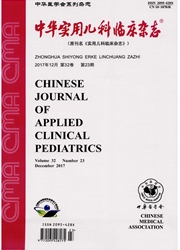

 中文摘要:
中文摘要:
目的探讨应用靶序列捕获和二代测序检测COL4A3、COL4A4和COL4A5基因诊断散发性Alport综合征的可行性。方法收集1例无家族性血尿和慢性肾衰竭家族史、拟诊Alport综合征的9岁男童的临床资料,采集患儿及其父母外周静脉血3 mL,提取基因组DNA,应用靶序列捕获和二代测序检测COL4A3、COL4A4和COL4A5基因及Sanger测序验证,并进行基因突变分析和文献复习。结果患儿1岁起病,表现为血尿、蛋白尿,间歇性肉眼血尿,逐渐进展至肾病水平蛋白尿;8岁7个月发现双耳感音神经性聋,临床拟诊为Alport综合征。在患儿COL4A4基因上发现3578-1G〉A及3967 C〉T(Q1323X)复合杂合致病突变,3578-1G〉A突变来自父亲,3967 C〉T突变来自母亲。该患儿确诊为常染色体隐性遗传型Alport综合征。结论对于临床拟诊的散发性Alport综合征,可应用靶序列捕获和二代测序检测COL4A3、COL4A4和COL4A5基因进行明确诊断。
 英文摘要:
英文摘要:
Objective To study the feasibility of testing three disease-causing genes for Alport syndrome, COL4A3, COL4A4 and COL4A5, in diagnosing patients with sporadic Alport syndrome by using targeted capture and next generation sequencing.Methods The clinical data of a 9-year-old boy suspected with Alport syndrome were collected.Genomic DNA was extracted using standard procedures from the peripheral blood leukocytes of the patient and his parents, respectively.Targeted capture and next generation sequencing and Sanger sequencing were applied to analyze the mutations in the 3 disease-causing genes.Clinical data of cases reported already with autosomal recessive Alport syndrome caused by the mutations in the COL4A4 gene were summarized.Results The patient was presented with neither family history of hematuria nor chronic renal failure.Haematuria and proteinuria were found at the age of 1 year.The patient presented with episodes of macrohaematuria and gradually developed nephrotic-level proteinuria.At the age of 8 years 7 months, bilateral sensorineural hearing loss was diagnosed.So a probable diagnosis of Alport syndrome was postulated.A compound heterozygous pathogenic mutations of 3578-1G〉A and 3967 C〉T(Q1323X)were identified in the COL4A4 gene in the patient.The mutation of 3578-1G〉A was inherited from his father, and the mutation of Q1323X from his mother.The patient was decisively diagnosed with autosomal recessive Alport syndrome.Conclusions The test of COL4A3, COL4A4 and COL4A5 genes can help diagnose patients with sporadic Alport syndrome by using targeted capture and next generation sequencing.
 同期刊论文项目
同期刊论文项目
 同项目期刊论文
同项目期刊论文
 期刊信息
期刊信息
